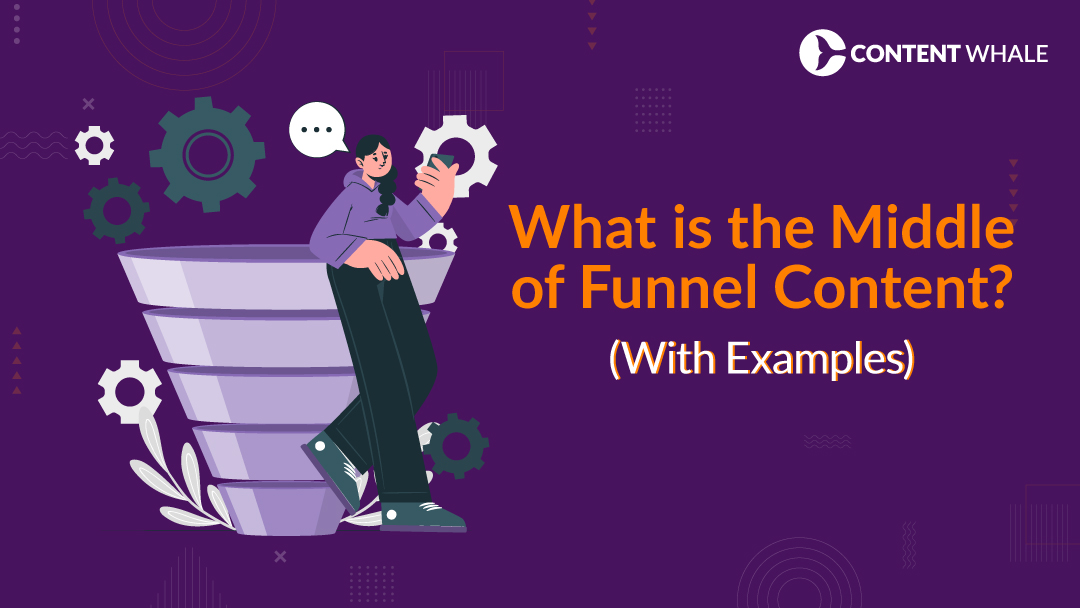Imagine spending countless hours developing the perfect lead magnet and cultivating a thriving email list. You’ve done everything by the book, yet there’s a deafening silence—your leads aren’t converting into customers. Where did things go off track? Often, the missing piece lies within your content strategy, specifically in how effectively you’re utilizing middle of the funnel content.
At this stage, you’ve successfully attracted an audience; they’re aware of your brand but aren’t quite ready to commit to a purchase. This is where MoFu content steps up, bridging the gap between initial interest and final decision-making.
Effective middle of the funnel marketing examples demonstrate the pivotal role this content plays in a prospective buyer’s journey, guiding them from curiosity to conversion.
Middle of funnel content examples show that MoFu isn’t just about keeping your audience engaged. It’s an opportunity to build trust and position your brand as a solution to their problems.
In the vast expanse of digital marketing MoFu, content that educates and solves problems turns passive interest into active engagement.
Understanding and implementing effective marketing funnel MoFu strategies can dramatically alter the performance of your campaigns. By nurturing leads at this critical stage, you’re not just selling, you’re building lasting relationships.
This content isn’t about making an immediate sale but about preparing leads for the next steps, ensuring they are informed, confident, and ready to proceed.
So, if you find your initial content efforts generating interest without conversion, it’s time to reevaluate your approach to middle of the funnel content. With the right strategy, you can transform silence into conversation and interest into action.
What is the Marketing Funnel?

To fully leverage middle of the funnel content, it’s essential to understand the marketing funnel’s structure and purpose. The marketing funnel is segmented into three primary stages: awareness, consideration, and decision, each catering to different consumer needs as they progress toward a purchase.
1. Awareness Stage
At the top of the funnel, potential customers first encounter your brand. The objective here is to capture their attention through compelling content and advertisements that resonate with their initial interests or needs. This stage is crucial for building a broad audience base.
2. Consideration Stage
As leads delve deeper, they enter the consideration phase where middle of the funnel content or MoFu content plays a pivotal role. This content type is designed to engage leads by providing more comprehensive insights into your products or services.
Effective middle of funnel content examples include detailed product comparisons, expert-written guides, or in-depth video tutorials that address specific questions or concerns potential customers might have.
3. Decision Stage
The final leg of the funnel is the decision stage, where leads are prepared to make a purchase. The marketing funnel MoFu strategies ensure that by this stage, potential customers are well-informed and confident in their decision, thanks to the detailed and engaging content provided earlier in the funnel.
Each stage of the funnel is integral to guiding potential customers through their journey. By understanding and implementing strategic digital marketing MoFu efforts, businesses can effectively convert initial awareness into concrete actions.
This strategic approach, highlighted through various middle of the funnel marketing examples, ensures that leads remain engaged and more likely to convert into paying customers.
What is MoFu Content?

Understanding middle of the funnel content (MoFu content) is key to optimizing the middle stage of your marketing funnel. This type of content targets potential customers who are already aware of your brand but need more information before they are ready to make a purchase.
Middle of the funnel content is designed to nurture leads by providing more detailed and specific information that aligns with their interests and needs. It serves to educate and persuade, setting the groundwork for the decision-making process.
This content typically answers more in-depth questions that arise as leads evaluate your products or services against their requirements and those of your competitors.
Effective middle of funnel content examples could include:
- Case studies that demonstrate how your product or service has solved problems for other customers.
- Product demonstrations or how-to videos that show your product in action.
- Webinars that offer a deeper dive into the features and benefits of your offering.
- FAQ pages that address common questions or concerns that prospects might have at this stage.
Each piece of MoFu content should aim to move leads closer to a purchasing decision by building trust and authority.
Through educational and engaging content, you can highlight the advantages of your solutions and how they stand out in the market.
Mastering digital marketing MoFu involves a strategic approach where content is not just seen but felt.
It should resonate with the audience’s growing understanding of their problems and your solutions, effectively bridging the gap between interest and purchase.
By leveraging robust middle of the funnel marketing examples, marketers can enhance their strategy to ensure that when leads exit the MoFu stage, they do so with a strong intent to purchase, well-informed about how your offerings align with their needs.
The Goals of MoFu Content
The objectives of middle of the funnel content are to educate, build trust, and guide potential customers toward making a purchasing decision.
This type of content plays a crucial role in the marketing funnel MoFu, where leads are aware of their needs and are considering various solutions. Let’s explore the key goals of MoFu content.
1. Educating Leads
At this stage, the information provided should help leads understand how your product or service can resolve their specific issues.
Detailed explanations, how-to guides, and webinars can educate consumers about the functionalities and benefits of your offerings, which are critical in the consideration phase of the purchasing journey.
2. Addressing Pain Points
Effective middle of the funnel content delves into common challenges or pain points that your target audience faces.
By presenting case studies or middle of funnel content examples, you can show how your solutions address these pain points, providing clear and practical benefits to potential customers.
3. Building Trust and Authority
Trust is a significant factor in any purchasing decision. Digital marketing MoFu strategies should include testimonials, expert opinions, and endorsements that highlight the reliability and credibility of your brand.
Providing proof of your industry expertise can significantly influence the decision-making process.
4. Guiding to Conversion
While it’s important to inform and engage at this stage, your content should also nudge leads toward making a decision.
This can be achieved through calls-to-action that invite further interaction, such as signing up for a free trial, scheduling a consultation, or viewing a product demo.
By achieving these goals, middle of the funnel content ensures that leads are well-prepared to move on to the decision-making stage.
This content not only supports leads through their buyer’s journey but also aligns closely with broader middle of the funnel marketing examples, which demonstrate the strategic placement of content within the overall marketing ecosystem.
Why is MoFu Content Important?

The significance of middle of the funnel content extends far beyond merely filling content calendars or maintaining engagement. This pivotal stage in the marketing funnel MoFu is about fostering trust and demonstrating value to your leads who are on the cusp of making a decision.
1. Fostering Lead Engagement
As potential customers progress from initial awareness, MoFu content keeps them engaged with relevant and substantial information. This continuous engagement helps maintain your brand’s presence in their consideration set as they evaluate their options.
2. Driving Conversions
Effective middle of the funnel content does more than inform; it persuades. By addressing specific concerns and showcasing the benefits of your solutions through middle of funnel content examples, you can influence buying decisions positively.
This targeted content nudges leads toward conversion by clarifying how your offerings are the right choice for their needs.
3. Building a Stronger Relationship
At this stage, leads are looking for reasons to choose your brand over competitors. Digital marketing MoFu strategies that focus on creating content that answers specific questions or resolves doubts can build a stronger relational foundation. When leads feel understood and valued, they are more likely to trust your brand and eventually convert.
4. Highlighting Competitive Advantages
Through well-crafted middle of the funnel content, businesses have the opportunity to highlight what sets their products or services apart.
This can be through detailed comparisons, expert insights, or showcasing superior features. Each piece of content should reinforce why your solution is the superior choice.
Neglecting middle of the funnel content can lead to a significant drop-off in lead engagement and conversion rates. It’s here that potential customers are actively looking for reasons to either choose you or move on to another option.
By investing in robust middle of the funnel marketing examples, businesses can ensure that their leads receive the right information at the right time, significantly increasing the chances of moving them towards a purchase.
Understanding Your MoFu Audience

Effective middle of the funnel content is tailored to meet the specific needs and preferences of your audience during the consideration stage of their buyer’s journey. This requires a deep understanding of who they are and what they seek at this point in their decision-making process.
1. The Importance of Audience Segmentation
Segmenting your audience allows for more personalized and targeted content creation. By understanding different segments within your target market, you can create MoFu content that speaks directly to the varied interests and challenges of each group.
Whether it’s industry-specific insights for B2B clients or product usage tutorials for tech-savvy consumers, segmentation ensures that your content resonates and is relevant.
2. Characteristics of the MoFu Audience
Leads in the middle of the funnel have moved past basic awareness and are actively considering their options. They often seek more detailed information about product specifications, pricing, and usability. They might compare your offerings with competitors’ or look for reviews and testimonials. Recognizing these behaviors is key to crafting content that addresses their more informed and specific inquiries.
3. Creating Buyer Personas
A buyer persona is a semi-fictional representation of your ideal customer based on market research and real data about your existing customers.
Developing detailed personas can guide your digital marketing MoFu strategy by highlighting what content will be most effective in addressing the unique concerns and interests of different segments of your audience. This might include demographic details, behavioral patterns, motivations, and goals.
By applying these insights to your marketing funnel MoFu strategies, you can create middle of the funnel content that not only captures interest but also builds momentum towards making a purchase.
Use middle of the funnel marketing examples to illustrate how products or services have successfully met similar needs or solved related problems. This approach not only informs but also reassures your audience that they are making the right choice progressing with your brand.
MoFu Content Formats and Examples

1. The Content Mix for MoFu Success
Diversifying the formats of your middle of the funnel content is essential for maintaining engagement and delivering value in ways that resonate with different audience preferences.
Here are some of the most effective content types for nurturing leads at this stage:
- Blog posts that provide in-depth analysis or advanced guides can answer specific questions and offer solutions to common issues faced by your audience.
- Ebooks and whitepapers offer detailed insights and comprehensive coverage of topics that help establish your brand’s authority and expertise.
- Webinars and online courses can be interactive and highly engaging, providing real-time solutions and expert advice.
- Infographics and videos make complex information easier to understand and consume, which is particularly useful for explaining detailed processes or data.
2. MoFu Content Examples in Action
To illustrate, consider a software company that uses a series of webinars to explain product features in-depth, each tailored to different user needs and complexity levels. This approach not only educates potential customers but also builds a community around their products. Another example might be a health and wellness brand that publishes comprehensive guides on nutrition and fitness, helping readers understand the science behind their recommendations.
3. Crafting Engaging MoFu Content
Creating engaging MoFu content involves more than just presenting information. It requires an approach that appeals directly to the interests and needs of your audience:
- Focus on value-driven content that educates and informs. Ensure each piece provides actionable insights or answers to potential questions.
- Address audience pain points directly by providing clear, concise, and practical solutions.
- Utilize storytelling to connect with your audience on an emotional level, making your content relatable and memorable.
- Employ strong calls to action (CTAs) that guide leads towards the next step, whether it’s downloading a resource, signing up for a webinar, or scheduling a demo.
- Optimize content for search engines (SEO) to improve discoverability. Use targeted keywords like digital marketing MoFu and middle of the funnel marketing examples strategically to attract more qualified leads.
By integrating these approaches into your digital marketing MoFu strategy, your middle of the funnel content can significantly influence potential customers’ decision-making processes, steering them closer to conversion.
Promoting Your MoFu Content

Successfully promoting middle of the funnel content involves identifying and utilizing the most effective channels to reach your audience during the consideration phase of their buyer’s journey.
Here’s how you can maximize the impact of your content and ensure it reaches the right people at the right time.
1. Distribution Channels for MoFu Content
To effectively promote MoFu content, consider the following channels:
- Email marketing campaigns are particularly effective for distributing MoFu content because they can be personalized based on the recipient’s previous interactions with your brand. For instance, sending a detailed case study to a lead who has downloaded an introductory ebook could nudge them closer to a purchase.
- Social media promotion (organic and paid) helps to enhance visibility and engagement. Platforms like LinkedIn for B2B and Facebook or Instagram for B2C can be excellent avenues for sharing content like webinars or detailed guides.
- Influencer marketing collaborations can expand your reach and lend credibility to your content. Partnering with respected figures in your industry to create or endorse your content can help tap into their followership, who likely trust their recommendations.
- Content syndication on relevant platforms can also increase the visibility of your MoFu content beyond your own channels. Look for industry blogs, forums, or websites that allow you to share your content or contribute as a guest author.
2. Optimizing Your Website for Conversions
Ensuring that your website is optimized to capture and convert traffic from your middle of the funnel content is vital:
- Landing pages should be clear, concise, and designed to convert. They need to provide all the necessary information a lead might need to make a decision and include a strong call to action.
- Lead capture forms should be simple and straightforward, requesting only essential information to reduce friction and increase the likelihood of conversion.
By strategically promoting your middle of the funnel content through these channels and optimizing your website for conversions, you can more effectively guide leads through the marketing funnel MoFu, improving overall engagement and increasing the chances of turning prospects into loyal customers.
Measuring MoFu Content Success

Effectively measuring the success of your middle of the funnel content is crucial for understanding its impact on lead progression and overall conversion rates. Here’s how to track and analyze the performance of your MoFu content.
1. Key Performance Indicators (KPIs) for MoFu Content
To gauge the effectiveness of middle of the funnel content, consider the following KPIs:
- Website traffic and engagement: Metrics like page views, time spent on page, and bounce rate can indicate how engaging your content is and whether it holds the interest of potential customers.
- Lead generation: Track how many leads are generated specifically through MoFu content via form submissions and email signups. This shows the content’s effectiveness in moving prospects deeper into the funnel.
- Click-through rates (CTRs) on your CTAs: Analyzing the CTRs on calls-to-action included in your MoFu content will help you understand how compelling your invitations to take further actions are.
- Customer acquisition cost (CAC): Calculating the CAC in relation to MoFu content campaigns can provide insights into the cost-effectiveness of your efforts in nurturing and converting leads.
2. Analytics Tools and Reporting
Utilizing the right tools is essential for accurately measuring the performance of your MoFu content. Tools like Google Analytics can track visitor behavior on your website, while CRM software can help monitor lead progression and conversions attributed to specific pieces of content. Here’s how to use these tools effectively:
- Set up goal tracking in Google Analytics to monitor specific interactions related to MoFu content, such as downloads, sign-ups, and time spent on important pages.
- Use UTM parameters to track the effectiveness of different distribution channels in driving traffic to your MoFu content.
- Regularly review and analyze the data to identify trends, patterns, and areas for improvement. Adjust your content strategy based on these insights to optimize the performance of future content.
By closely monitoring these metrics and regularly adjusting your strategy based on data insights, you can enhance the effectiveness of your digital marketing MoFu efforts and better drive leads towards conversion.
This continual improvement process ensures that your middle of the funnel content remains a robust tool in your marketing arsenal, effectively addressing the needs and interests of your audience as they move towards making a purchase.

Recapping the importance of middle of the funnel content is essential to understanding its role in your overall marketing strategy. This type of content bridges the gap between initial awareness and the final decision to purchase, playing a pivotal role in nurturing leads.
Middle of the funnel content, when executed well, educates and engages potential customers who are considering your products or services. It addresses their specific concerns and questions, providing the necessary information to move them closer to a decision.
With effective middle of funnel content examples, businesses can demonstrate their expertise and the unique benefits of their offerings, thereby increasing the likelihood of conversion.
Reflecting on the value of MoFu content reminds us that successful marketing strategies are about more than just attracting leads; they’re about conversion. Every piece of content should serve a specific purpose in guiding leads through the marketing funnel MoFu, ensuring that they receive relevant information at the optimal time.
As we conclude, consider the role that middle of the funnel content plays in your marketing efforts. Are you effectively using MoFu content to transform interest into action?
Take this opportunity to review your current strategies and implement the insights shared throughout this guide.
For those looking to enhance their digital marketing MoFu tactics, start by revisiting your audience’s needs during the consideration phase and refine your content to address these needs more precisely.
Employ a variety of middle of the funnel marketing examples to enrich your approach, and always be prepared to adapt based on performance metrics.
Embrace the power of middle of the funnel content to not only attract but also retain and convert your leads into loyal customers.
With the right strategies in place, your marketing funnel will not just function; it will flourish.

What if I don’t have the resources to create a lot of MoFu content?
Creating high-quality middle of the funnel content on a budget is possible with a few strategic approaches:
- Repurpose existing content: Convert your top-performing blog posts into videos, infographics, or podcasts to engage different segments of your audience without the need for entirely new content.
- Collaborate with guest writers: Inviting experts to contribute to your blog or webinar series can provide fresh perspectives and valuable content without significant resource investment.
- Leverage free design tools: Use platforms like Canva or Adobe Spark to create professional-looking graphics and layouts that enhance the appeal of your content without the cost of professional design services.
How can I personalize my MoFu content for different audience segments?
Personalizing MoFu content involves understanding and addressing the unique needs of different segments of your audience:
- Use audience segmentation tools: These tools can help you categorize your audience based on demographics, behavior, or purchase history, enabling tailored content strategies.
- Dynamic content delivery: Implement technology that adapts the content displayed on your website or in emails based on the viewer’s past interactions with your brand.
- Email marketing personalization: Customize email campaigns with the recipient’s name, content relevant to their interests, and behavior-based triggers to increase engagement.
How often should I be publishing MoFu content?
The frequency of publishing middle of the funnel content should be dictated by your audience’s engagement and consumption habits. A consistent schedule that keeps your brand at the forefront of their minds without overwhelming them is ideal—this might mean weekly, biweekly, or monthly, depending on your resources and the depth of content your team can produce.
I’m still not sure what type of MoFu content would work best for my audience. What should I do?
Determining the most effective MoFu content for your audience requires:
- Conducting market research: Gather data on your audience’s preferences and needs to inform your content creation.
- Analyzing competitor content: Look at what your competitors are doing and identify gaps in their content strategies that you can fill.
- Leveraging audience insights tools: Utilize tools that provide data on your audience’s online behaviors and preferences to tailor your content more effectively.
How can I measure the ROI of my MoFu content efforts?
Measuring the ROI of your middle of the funnel content involves tracking specific metrics:
- Lead generation: Monitor how many new leads are generated from your MoFu content.
- Conversion rates: Track how many of these leads convert into paying customers.
- Customer Lifetime Value (CLTV): Assess the value your content brings over the lifespan of a customer relationship to better understand its long-term impact.
What are some common mistakes to avoid when creating MoFu content?
Avoid these pitfalls to maximize the effectiveness of your middle of the funnel content:
- Focusing on sales pitches: MoFu content should educate and engage, not hard sell. Keep the content informative and useful.
- Neglecting audience targeting: Ensure your content is crafted to address the specific needs and interests of your audience segments.
- Failing to track and optimize content performance: Continuously analyze how your content performs and make adjustments to improve its effectiveness and relevance.





